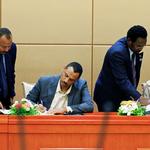The Sudan-Ethiopia border needs a soft border solution
Since December 2020 the situation on the border between Ethiopia and Sudan has been at a breaking point, with the two countries’ armed forces clashing in several rounds. How can the tension be relieved? A bi-lateral demarcation combined with a soft border solution could be the answer.
The contested Al-Fashaga triangle
The increased tension on the Sudanese-Ethiopian border comes in the wake of fundamental political ruptures in both countries. But the root of the tension goes a long way back in history, and relates to contested and un-demarcated colonial borders between the two countries and widespread cross-border movement.
The border conflict’s hotspot is known as the Al-Fashaga triangle. The Al-Fashaga triangle covers about 250 square kilometres and has about 600,000 acres of fertile land, naturally watered by three rivers – Setit, Atbara, and Basalam. In addition to livestock herding and farming, seasonal agricultural work, with workers migrating from both sides of the border, constitutes a major livelihood in the area.
Ethiopian militias, known as shifta, have been active along the Sudan-Ethiopia borderfor the last three decades. The shifta have a long history of violent clashes with Sudanese farmers and pastoralists. The Sudanese rural households in the area have reported incidents where the shifta have seized their crops, looted livestock and even taken hostages. Lives have been lost and billions of Sudanese pounds paid as ransom to free the victims. The shifta activity in the area severely impacts their livelihood. The situation is further complicated by the fact that many Sudanese farmers rely on Ethiopians, aslabourers migrating across the border during harvesting season.
The shifta have a long history of violent clashes with Sudanese farmers and pastoralists.
For people on the Ethiopian side of the border, the opportunity to seasonally migrate to Al-Fashaga has provided an important source of additional income. In the dry season, the triangle’s three rivers have been crucial water sources for migrating cattle.
Many agreements, no result
Peaceful co-existence between Ethiopians and Sudanese in this area has always been highly dependent on the two national governments’ ability to be on friendly terms with each other and with the local shifta and their Sudanese counterparts. Throughout history, the border tension has escalated when Addis Ababa and Khartoum have been at odds, and when local forces on both sides have been allowed to promote hostile local territorial claims, provoking the other side.
The 1902 treaty between Ethiopia and colonial Great Britain is the main document delimiting the border between Ethiopia and Sudan, but the process leading up to the demarcation was never considered legitimate by the Ethiopian government. New attempts in 1903 and 1972 also failed to be ratified by the Ethiopians. Since then, the borderline has been contested. When the two governments have been on good terms, ad hoc solutions to the border issues have been found. Yet, the fact that all agreements have remained non-institutionalised has made it possible for both sides to contest them in times of conflict. The informality has also implied a lack of transparency, and thereby a lack of trust in the processes from the public opinion and opposition parties in both countries.
When the two governments have been on good terms, ad hoc solutions to the border issues have been found.
The lack of transparency and public trust was particularly apparent in the border dealings between Sudan’s president Omar Al Bashir (1989-2019) and the Ethiopian Peoples Revolutionary Democratic Front (1991-2018). While the two governments achieved a kind of soft border agreement during the first decade of the 2000s, it was also perceived as a murky deal by opposition forces on both sides. The Ethiopian opposition accused the EPRDF of offering large territories of the Amhara region to Sudan. The Ethiopian government, however, claims it only gave back land occupied from Sudanese farmers in 1996. Despite numerous meetings on the border issues, the two countries have never reached an agreement.
Vested interests
On 15 December 2020,Sudanese sources reported that anarmed forces patrol came under artillery shelling from Ethiopian troops in the Abu Toyour area in Al-Fashaga. Ten soldiers were killed, ten others were wounded, several were captured and army cars were damaged.The Ethiopian government was keen to downplay the importance of the incident, and Prime Minister Abiy Ahmed tweeted on 17 December,2020: ‘The gov’t is closely following the incident with local militia on the Ethio-Sudan border. Such incidents will not break the bond b/n our two countries as we always use dialogue to resolve issues. Those fanning discord clearly do not understand the strength of our historical ties.’
But local actors on the Ethiopian side, Amhara farmers and the so-called Fano militia (Amhara youth groups), in collaboration with the Amhara regional government and regional armed forces, have their own agenda determined by the desire to access farming and cattle rearing land in Al-Fashaga. After the war broke out in Tigray in northern Ethiopia, these forces have become a key ally of Prime Minister Abiy Ahmed against the Tigray Defence Forces (TDF). They therefore enjoy a strong position of influence in Ethiopia, and their demands in Al-Fashaga have remained unchecked by Addis Ababa. In Sudan, president Bashir’s fall has created a power vacuum, which the armed forces intend to fill, making it paramount for the military to show their strength towards Ethiopia in the border areas. In mid-December 2020, the head of the Sudanese Sovereign Transitional Council, Lieutenant General Al-Burhan, launched an operation to try to recover all of the contested territories. The Sudanese government has since announced that they have taken control of 95% of the Al-Fashaga triangle. According to the Lt Gen Al-Burhan, 96 Sudanese soldiers have lost their lives since the launch of operation till end of November 2021. The numbers of casualties on the Ethiopian side are not known. A meeting held in the Sudanese capital Khartoum on December 22-23 2020 between the authorities of Sudan and Ethiopia to cease the conflict and demarcate their border ended without yielding a solution.
Local voices and initiatives for peace
On 20 June 2021, in a Sudanese-Ethiopian military meeting in Gallabat, the two parties mutually agreed to refrain from supporting hostilities. But fighting soon resumed and the agreement collapsed. In the aftermath of the disappearance of a Sudanese military commander pursuing Ethiopian militias for allegedly kidnapping three Sudanese children in Gallabat town, the Sudanese authorities closed the border crossing between Gallabat in Sudan and Matama in Ethiopia. For communities on both sides of the border, this particular crossing is considered to be a lifeline, and the closure weakened their income and opportunities to interact. Regular, legal interaction was replaced by human trafficking and smuggling of goods using illegal entry points, exposing the border population to even further risks.
For communities on both sides of the border, this particular crossing is considered to be a lifeline, and the closure weakened their income and opportunities to interact.
To ease tension and push for a re-opening of the border crossing, the Ethiopia-Sudan People’s Friendship Association, in cooperation with border traders and border communities in Gallabat and Matema, initiated a dialogue between border traders and border communities in Matema as well as the Sudanese and Ethiopian authorities The initiative was meant to normalize relations between the two sides, to create a healthy environment for cooperation and communication, and to open up for constructive and fruitful dialogue. The initiative succeeded in bridging the gap between Sudanese and Ethiopian authorities. The border eventually re-opened for a while and several prisoners taken hostage were released.
The border communities’ initiative demonstrates how different life is seen from the perspective of the big city and the people who live along the border. Where Khartoum and Addis Ababa react by closing the borders between the two countries, the local communities take initiatives to ease the tensions and accommodate free movement across the borders despite obstacles imposed by regional and federal authorities. All evidence shows that local border communities thrive with soft borders. Problems arise when Khartoum and Addis Ababa relations break down. The only way to settle the issue is to listen to and take into account the interests of the local communities along the border.
All evidence shows that local border communities thrive with soft borders.
For this to happen, the national governments must keep destructive local actors in check. A continuing conflict in Tigray and Amhara nationalist sentiments running high paves the way for Amharan actors to pressure the Ethiopian federal government into enforcing territorial interests in the area. The Ethiopian government’s accusations that Sudan is supporting the Tigray Defence Forces complicates the situation further. The constructive local dialogue initiative could be in danger of being undermined by political actorson the national level. The only way forward is to involve both national, regional and local forces in the dialogue and to hold them all accountable.
Adam Babekir is coordinator and researcher at the Center for Migration Studies at the University of Gadarif. His research focuses on border issues and migration in Horn of Africa.
Lovise Aalen is senior researcher at Chr. Michelsen Institute. She has researched African politics for the last two decades (including several long term fieldworks), and has developed an extensive knowledge of the social, economic and political conditions of the wider Horn of Africa region in particular.
The views expressed in this post are those of the authors, and do not necessarily reflect the opinions of the ARUS project or CMI.
Adam Babekir





